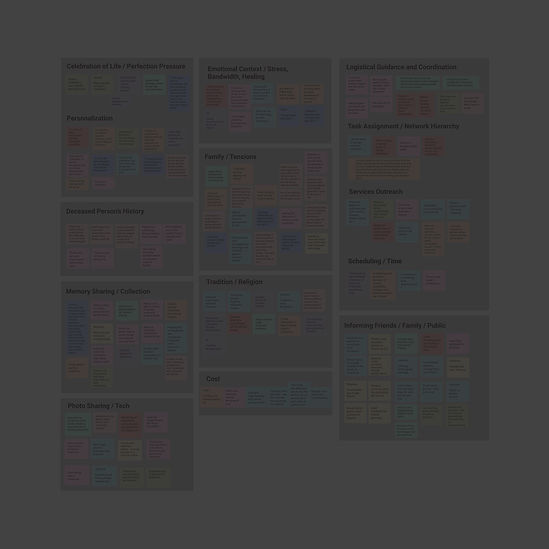
HARPER PROJECT
A research project to learn how grieving families approach the funeral planning process
THE PROBLEM
Death is never easy, but planning a funeral shouldn’t have to be so hard.
Grieving families are responsible for planning the funerals of their loved ones.
-
How do families typically approach this process?
-
Is there something that could make this easier to lessen their burden during a challenging time?
Funeral planning is something most people don’t think about until they’re in the midst of it themselves. It can be a complicated process during a painful time and many families are unprepared.
KEY GOAL
Investigate how grieving families plan a funeral and identify shared pain points.
MAKE OF THE TEAM
-
Chelsea Polak
-
Carina Gormley
TOOLS
-
Figma
-
Zoom
-
Google Drive
-
Google Forms
UNDERSTANDING THE PROBLEM
There must be something out there already
I scoured the internet in search of funeral planning resources - as a potential user initially and as a researcher later. I was discouraged to find that users have two main options.
1. Pay for a funeral planner - This costly option is popular for families who can afford it. It's created an entire industry that capitalizes on the loss of life.
2. DIY with little support - With some know-how and determination, it is entirely possible to plan a funeral without the support of a professional. However, it is challenging and time-consuming.
UNDERSTANDING THE USER
Conversations about planning family members’ funerals
We wanted to talk to people with backgrounds and cultures different from our own to help control for bias so we sent out a Screener Survey and began recruiting for remote user interviews, which lasted approximately 30 minutes each.
Participants were sent a consent form before their interview and asked to verbally confirm their agreement to have the conversation recorded. This was important so I could give them my undivided attention during a comfortable one-on-one discussion. I used the recordings to take detailed notes.
A list of guiding questions was prepared in advance to ensure some consistency between our interviews, but each interview was unique, which provided more interesting insights and prompted us to ask questions that we hadn’t even thought of.
Being mindful of the fact that these participants were being asked to reflect on a painful time, I relied on my counseling skills more heavily than I normally would. Rather than asking a set list of questions, I allowed the participant to guide the conversation and prompted them to continue by mirroring their statements, crafting empathic responses, and asking open-ended questions.
THESE WERE SOME MAJOR LEARNINGS OR POINTS WE WANTED TO CALL OUT
Insight #1:
Value differences based on generation
-
Younger gen. values personalization
-
Older gen. values tradition
Problem Statement:
How might we create a service that meets the needs of these two different generational preferences re funeral planning and commemoration?
Insight #2:
There is little clarity and guidance about what to do and people have different values that need to be accounted for
Problem Statement:
How might we empower users with the step-by-step info around funeral planning while allowing ample room for customization?
Insight #3:
Delegating tasks and communicating to deal with the logistics is a major pain point
Problem Statement:
How might we create a better communication medium that allows for tasks to be effectively delegated to others involved and for everyone to have access to shared information?
Insight #4:
Involving groups outside of the family (vendors and attendees) is often time-consuming and overwhelming.
Problem Statement:
How might we help organizers define and facilitate the involvement of these different groups of people?
Insight #5:
Organizers have different levels of emotional energy -- these discrepancies can add stress and worsen the planning experience.
Problem Statement:
How might we provide support that matches the emotional needs and capabilities of organizers?
TITLE OF THE CALLOUT BLOCK
EMPATHIZING WITH OUR USERS
With a better understanding of our users and their goals, we created two distinct personas that reflect key primary users with differing points of view and varying pain points.
We created secondary personas as well so we would have quick language for discussing their role in the process.
NEXT STEPS:
Talk to more people
-
"Marilyn" User Interviews - Conduct user interviews with an older demographic. Our insights told us that there are 2 main personas we need to design for and our participants tended to be similar to Jason, not Marilyn.
-
Expert Interviews - Talk to professional funeral planners to learn what they think about the funeral planning process.
Design Intentionally
-
Sketching - Put pen to paper for quick ideation and iterate based on feedback.
-
Wireframing - Digitizing our sketches
-
Prototyping- Bringing our design to life
-
Usability testing - Watch as several participants navigate through the product and reflect on what went well and what needs to be improved.
-
Heuristic evaluation - We determined usability is one of our top priorities as designers for this product so it's important to have several methods for improving it.


